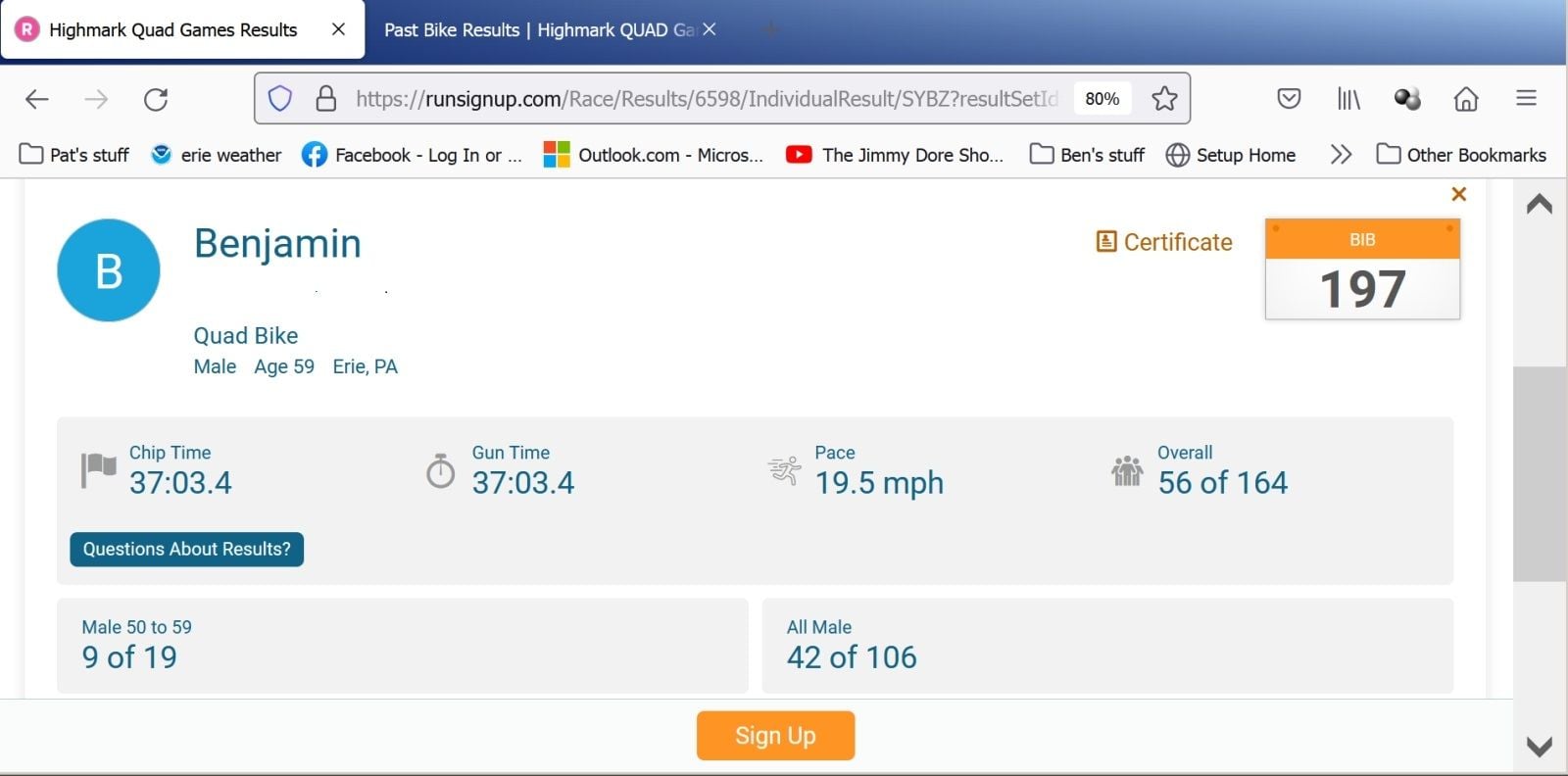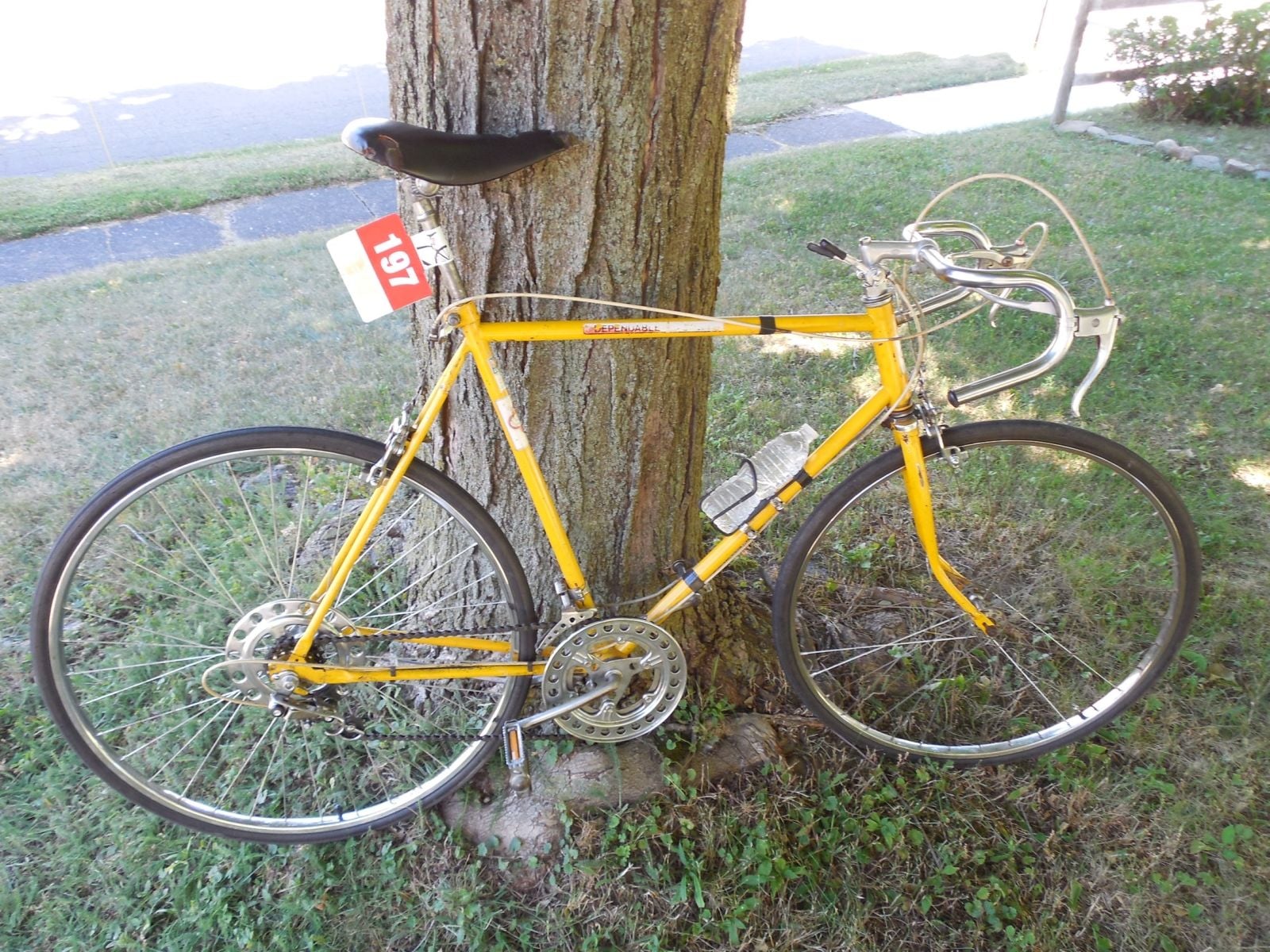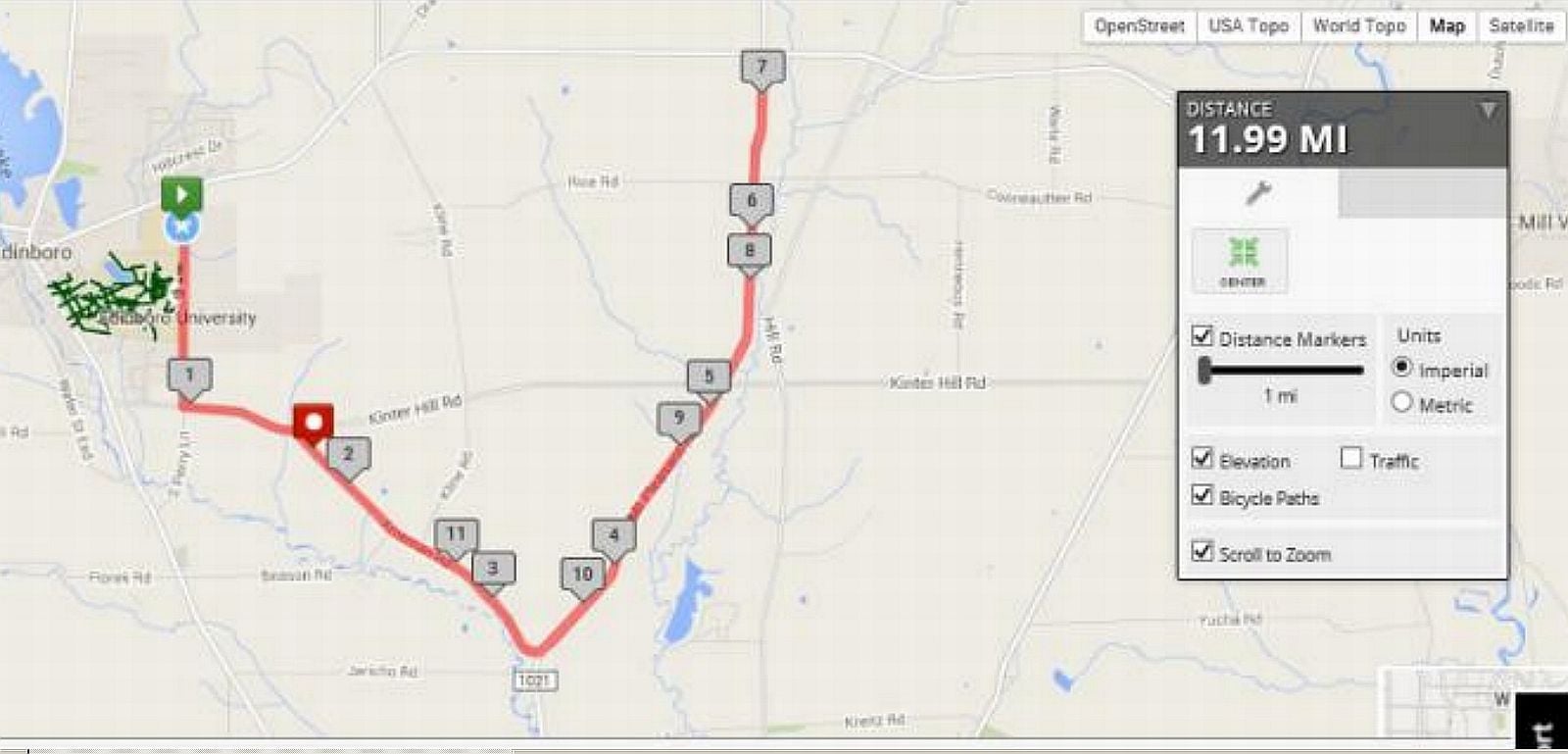Can +, -, wind,hills ever be a plus in a race?
#1
Banned
Thread Starter
Join Date: Feb 2014
Posts: 678
Mentioned: 11 Post(s)
Tagged: 0 Thread(s)
Quoted: 790 Post(s)
Liked 348 Times
in
195 Posts
Can +, -, wind,hills ever be a plus in a race?
There are a few public road routes locally which are regularly used for bicycle time-trials, one is an elongated loop that is very flat and under ideal conditions needs no shifting, the other a "C" shape that is ridden out and back in to complete the event and is always rising/falling along with a few hills that require shifting. Both routes have their stop/start at about the same elevation. Having ridden both routes in windy conditions, it does not seem like normal winds affect the time around the loops much, neither do the hills. So it is likely that the wind, inclines give back as much as they take. I am sure if the wind was ridiculously high, say 30mph or more, this may not be true, but then I would probably not want to go out for a ride anyway.
What I was wondering, was could it be possible that more time is made up going downhill that is lost going uphill, and could more time be gained riding with the wind for a distance than is lost riding against it? I rode the one long oval route today and parts of it had a very still breeze that demanded getting the body horizontal as possible to keep speed, but I turned as good a time around it as I have in the last year. And on the "C" route yesterday there was also a stiff breeze on parts of it and I was not used to the hills and shifting as I do not ride that route as much, but it did not seem to affect total time either. Of course on any downhill or any section with the wind nuetral or on my back I took full advantage.
Maybe no scientific measuring has ever been done on this subject, but for me it seems that as long as I stay down on the drops and keep working things seem to even out within reason. But if there is some data out there it would be nice to know about it as it may help riding technique.
What I was wondering, was could it be possible that more time is made up going downhill that is lost going uphill, and could more time be gained riding with the wind for a distance than is lost riding against it? I rode the one long oval route today and parts of it had a very still breeze that demanded getting the body horizontal as possible to keep speed, but I turned as good a time around it as I have in the last year. And on the "C" route yesterday there was also a stiff breeze on parts of it and I was not used to the hills and shifting as I do not ride that route as much, but it did not seem to affect total time either. Of course on any downhill or any section with the wind nuetral or on my back I took full advantage.
Maybe no scientific measuring has ever been done on this subject, but for me it seems that as long as I stay down on the drops and keep working things seem to even out within reason. But if there is some data out there it would be nice to know about it as it may help riding technique.
#2
Perceptual Dullard
Join Date: Sep 2009
Posts: 2,420
Mentioned: 36 Post(s)
Tagged: 0 Thread(s)
Quoted: 919 Post(s)
Liked 1,156 Times
in
494 Posts
But TTs are done in competition against others. There are conditions (wind, hills) where even though everyone is slower, you might lose less than they do. At least, that's what you're aiming for.
Likes For RChung:
Likes For topflightpro:
#5
Banned
Thread Starter
Join Date: Feb 2014
Posts: 678
Mentioned: 11 Post(s)
Tagged: 0 Thread(s)
Quoted: 790 Post(s)
Liked 348 Times
in
195 Posts
I found some charts from research on Sheldon Brown's site about rider speed vs. wind from different directions, and it backs up that you can not use a tail-wind to make up all of the losses incurred fighting a head-wind. Looked pretty legit. Info on whether going down a hill can make up all the loss from going up it seems harder to find.
One thing the Sheldon Brown site says is that a headwind from the front 200 degrees slows a rider down, while a tailwind has to come from only 160 degrees to be helpful, so not being a 180/180 split right off the bat puts the rider at a disadvantage.
One thing the Sheldon Brown site says is that a headwind from the front 200 degrees slows a rider down, while a tailwind has to come from only 160 degrees to be helpful, so not being a 180/180 split right off the bat puts the rider at a disadvantage.
#6
Not actually Tmonk
Join Date: Jun 2007
Location: San Diego, CA
Posts: 14,132
Bikes: road, track, mtb
Mentioned: 140 Post(s)
Tagged: 0 Thread(s)
Quoted: 2638 Post(s)
Liked 3,151 Times
in
1,658 Posts
some empirical evidence would be to look at pro TT speeds. Flatter course = faster times over a given distance, on average
__________________
"Your beauty is an aeroplane;
so high, my heart cannot bear the strain." -A.C. Jobim, Triste
"Your beauty is an aeroplane;
so high, my heart cannot bear the strain." -A.C. Jobim, Triste
#7
Version 7.0
Join Date: Oct 2006
Location: SoCal
Posts: 13,127
Bikes: Too Many
Mentioned: 297 Post(s)
Tagged: 0 Thread(s)
Quoted: 1340 Post(s)
Liked 2,482 Times
in
1,457 Posts
No. The problem is the time that is lost into the wind or on a climb is not recovered from a tailwind or downhill. The way to prove this is ride real time trials against the clock with others. Any wind or elevation change slows rider speed.
Coaches tell time trialists to apply more power into the wind and on climbs to reduce the amount of time spent climbing or into the wind. And the amount of power increase varies by individual. Too much power applied on a climb may result in insufficient energy later in the race.
And wind can affect riders due to rider weight, experience and wheel selection. Heavier riders are more stable in cross winds and experienced riders do not change power while being blown around by the wind. A trispoke front wheel may be a fast choice in light or moderate winds for a heavier experience rider but a poor choice for a light rider or inexperienced rider who will reduce power when the wind gust hits the front wheel and causes the bike to swerve slightly.
All the factors above result in small changes in time over the course. The better the course management by proper wheel selection and power application the faster the time for given wind and terrain conditions.
Coaches tell time trialists to apply more power into the wind and on climbs to reduce the amount of time spent climbing or into the wind. And the amount of power increase varies by individual. Too much power applied on a climb may result in insufficient energy later in the race.
And wind can affect riders due to rider weight, experience and wheel selection. Heavier riders are more stable in cross winds and experienced riders do not change power while being blown around by the wind. A trispoke front wheel may be a fast choice in light or moderate winds for a heavier experience rider but a poor choice for a light rider or inexperienced rider who will reduce power when the wind gust hits the front wheel and causes the bike to swerve slightly.
All the factors above result in small changes in time over the course. The better the course management by proper wheel selection and power application the faster the time for given wind and terrain conditions.
Likes For Hermes:
#8
Banned
Thread Starter
Join Date: Feb 2014
Posts: 678
Mentioned: 11 Post(s)
Tagged: 0 Thread(s)
Quoted: 790 Post(s)
Liked 348 Times
in
195 Posts
Well my combined rider/bike weight is about 240 pounds, not because I am fat but I am tall, just a bit under 6'3". Never had fancy wheels so cross-winds never bothered me much. I like the idea of spending the least time possible in a headwind or on a hill. My plan for the TT coming up this weekend is to try to hit the steeper hills as fast as possible to avoid shifting, as they are not that long. Weather forecast is looking good so far. On the slighter up and down grades I will simply keep down and pedal like hell.
Likes For beng1:
#9
pan y agua
Join Date: Aug 2005
Location: Jacksonville
Posts: 31,303
Bikes: Willier Zero 7; Merlin Extralight; Calfee Dragonfly tandem, Calfee Adventure tandem; Cervelo P2; Motebecane Ti Fly 29er; Motebecanne Phantom Cross; Schwinn Paramount Track bike
Mentioned: 17 Post(s)
Tagged: 0 Thread(s)
Quoted: 1447 Post(s)
Liked 727 Times
in
372 Posts
Well my combined rider/bike weight is about 240 pounds, not because I am fat but I am tall, just a bit under 6'3". Never had fancy wheels so cross-winds never bothered me much. I like the idea of spending the least time possible in a headwind or on a hill. My plan for the TT coming up this weekend is to try to hit the steeper hills as fast as possible to avoid shifting, as they are not that long. Weather forecast is looking good so far. On the slighter up and down grades I will simply keep down and pedal like hell.
Hermes pretty much nailed it. To quantify it, I like the 5% solution. Figure the power you can sustain for the entire TT. For uphill or headwind sections go above threshold, ie 105% to minimize time loss in the slower sections. Then back off just a touch, ie to 95% on the fast sections to recover, knowing your losses on the fast section will be less than the time gained by pushing the hard part.
of course the precise pacing will depend on the course, but the idea is harder on the hard parts, easier on the easier parts.
__________________
You could fall off a cliff and die.
You could get lost and die.
You could hit a tree and die.
OR YOU COULD STAY HOME AND FALL OFF THE COUCH AND DIE.
You could fall off a cliff and die.
You could get lost and die.
You could hit a tree and die.
OR YOU COULD STAY HOME AND FALL OFF THE COUCH AND DIE.
Likes For merlinextraligh:
#10
Newbie racer
Join Date: Feb 2018
Posts: 3,406
Bikes: Propel, red is faster
Mentioned: 34 Post(s)
Tagged: 0 Thread(s)
Quoted: 1575 Post(s)
Liked 1,569 Times
in
974 Posts
Zero wind:
out: 10min 5mi 30mph
back: 10min 5mi 30mph
Total: 10 + 10 = 20min
20mph wind "effect", as just because the forecast says "20mph winds" that's not necessarily how it plays out at ground level:
out: 30min 5mi 10mph (10mph is 30mph minus 20mph of wind)
back: 6min 5mi 50mph (50mph is 30mph plus 20mph of wind)
Total: 30 + 6 = 36min
On the very windy route, it's possible to make a leg of the route SO slow that the time just for that leg exceeds the entire time spent for out AND back on a windless day. That's the math. I made it extreme to prove the point.
Same thing for a hill, but for a hill you get back less because going up you have less loss for wind resistance at slower speeds than going down. And going down has a lot more wind resistance loss than riding the flats.
So, that's all there is to it. The art or magic is in doing enough practice at the race of truth to learn and know the balance between physiological expenditure for given time periods where it benefits you to in the headwind/uphill scenarios.
The thing about the 5%, that works well probably for head/tailwinds. But maybe not all hilly or technical courses. Then the 5% may be 10% uphill extra instead of 5% simply because the course won't let you spread the butter on the bread thin enough.
People watch pro TT's sometimes and forget many of the courses are not loops or out/back. But point to point. So be careful assuming anything that they can do 32mph runs on hills. Sometimes they have net elevation losses OR net downwind situations. OR sometimes the opposite. Often amateur TT's end where they start for permitting/safety and logistical reasons.
Likes For burnthesheep:
#11
Banned
Thread Starter
Join Date: Feb 2014
Posts: 678
Mentioned: 11 Post(s)
Tagged: 0 Thread(s)
Quoted: 790 Post(s)
Liked 348 Times
in
195 Posts
The Time-trial was now two weeks ago today. It was the out-and-back course with a slow turnaround at the halfway point and constant grades and hills the entire 12-mile distance but nothing that required shifting down more than one gear. I ran a 52 front chainwheel and used the 18.19 and 21 cogs on the rear. Despite not being familiar with the course, getting a horrible night's sleep, not liking the course, a bit of a breeze and some shifting mistakes, I finished at about exactly the speed I thought I might. I went fast as I could on the downhills, as fast as I could on the uphills, and as fast as I could into any wind or breeze, religiously staying as low as was possible. At first results said my average was 19.5mph, then after a few days I checked the website again and they had dropped it to 19.4-something, they also changed the other competitors times and finishing places, so I guess whoever they hired to time the event had some problems. Thanks-all for the input, it was my first serious stab at a time-trial in 25 years. 25 years ago in the same time-trial, same route, I did 33 minutes and placed 40th out of 401 entrants.






Likes For beng1:
#12
Disco Infiltrator
Join Date: May 2013
Location: Folsom CA
Posts: 13,446
Bikes: Stormchaser, Paramount, Tilt, Samba tandem
Mentioned: 72 Post(s)
Tagged: 0 Thread(s)
Quoted: 3126 Post(s)
Liked 2,105 Times
in
1,369 Posts
Watching that downhill pass by Pidcock, ha.
__________________
Genesis 49:16-17
Genesis 49:16-17
#13
Banned
Thread Starter
Join Date: Feb 2014
Posts: 678
Mentioned: 11 Post(s)
Tagged: 0 Thread(s)
Quoted: 790 Post(s)
Liked 348 Times
in
195 Posts
Being smart about navigating a turning/twisting route can definitely put a rider ahead of the competition, that would be a whole thread in itself though. I used to be a big motorcycle road-racing fan, and rode motorcycles a lot fast around paved turns with my knee down close to the ground. There are some good books on motorcycle road-racing that show lines through turns, and which talk about navigating twists and turns in a road, also in books about automobile racing too. I am sure a lot of cyclists never think much about gaining time where there are sharp turns in a course, but I always have because of my background in fast motor vehicles. It does not matter if the twisting road is on a hill though, the gains can be made very well on the flat. In the TT a few weeks ago there were a number of turns from one road to another, and places where the route curved, on flats and on hills, and despite not knowing the course as well as I should, I may have had an edge in the turns staying on the inside and being able to keep speed up around sharp corners by clipping apexes and making the turns wider so they could be taken at higher speeds safely.
#14
Disco Infiltrator
Join Date: May 2013
Location: Folsom CA
Posts: 13,446
Bikes: Stormchaser, Paramount, Tilt, Samba tandem
Mentioned: 72 Post(s)
Tagged: 0 Thread(s)
Quoted: 3126 Post(s)
Liked 2,105 Times
in
1,369 Posts
It wasn't just the hill or the lean angle. He took the draft, much stronger downhill due to the speed, to slingshot around like auto racing. Like everyone complains never happens in F1. He's definitely doing as much as he can with leaning off but it's still a bicycle, you can't really get off to put a knee down. If you put the inside leg down so the outside leg was high enough to get off to the inside, you would scrape the inside pedal.
Granted this is not a TT!
Granted this is not a TT!
__________________
Genesis 49:16-17
Genesis 49:16-17
Last edited by Darth Lefty; 07-24-22 at 12:23 PM.











